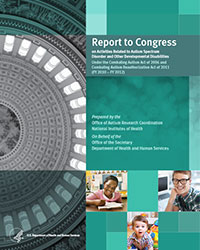Report to Congress
On Activities Related to Autism Spectrum Disorder and Other Developmental Disabilities
FY 2010 - FY 2012
This section addresses Subsection (4) of 399DD: "Information on the average age of diagnosis for children with ASD and other developmental disabilities, including how that age may have changed over the 4-year period beginning on the date of enactment for this Act." Information on the average age of diagnosis for individuals with ASD is provided by the CDC and HRSA.
Centers for Disease Control and Prevention (CDC)
Most children who have autism are not diagnosed until after they reach age 4, even though many children can be identified before age 2. For the most recently published ADDM Network ASD prevalence study, which was based on children who were 8 years old in 2008 and the diagnostic criteria in the Fourth Edition, Text Revision of the Diagnostic Statistical Manual of Mental Disorders (DSM-IV-TR), the median age of earliest known diagnosis was reported by subtype category.43 Age of first diagnosis ranged from 48 months for children diagnosed with Autistic Disorder (a more restrictive category suggesting higher severity of symptoms), to 53 months for children diagnosed under the more general category of Pervasive Developmental Disorder or autism spectrum disorder, and 75 months for children whose first diagnosis was Asperger Disorder (a category describing children without significant delays in language development or intellectual ability). About 20 percent of these children had a different subtype diagnosed after their initial diagnosis, so there is some instability in these subtypes over time. It is unclear if this instability is due to challenges in the diagnostic presentation of the children. Relatively equal mixes of children were initially diagnosed with Autistic Disorder or Pervasive Developmental Disorder, but only 9 percent of children had an initial diagnosis of Asperger Disorder.
Many people have asked whether the 23 percent increase in identified prevalence between 2006 and 2008 could be attributed to an increase in the proportion of children diagnosed under any particular subtype. Combined data from the 11 sites that completed both the 2006 and 2008 surveillance years shows virtually no change in the distribution of subtypes, the proportion of children with information available on subtype, or the median age of earliest known diagnosis under each subtype. While the median age and distribution of autism diagnoses has not changed substantially over time, there has been improvement in the proportion of children diagnosed by 3 years of age. In sites completing both the 2002 and 2008 surveillance years, the proportion of children diagnosed by 3 years of age increased from 12 percent to 18 percent.
CDC supports the Healthy People 2020 objective of increasing the proportion of children who are screened for autism and other developmental delays at 18 and 24 months of age and have a first evaluation by 36 months of age. For those with ASD, CDC supports increasing the proportion of children that are enrolled in special services by 48 months of age. An analysis of data from the 2007 National Survey of Children's Health (NSCH) indicates that only 21 percent of parents with children aged 10-47 months report that they were asked to fill out a questionnaire by a health care provider about their child's developmental, communication, or social behaviors in the last year.
Health Resources and Services Administration (HRSA)
The Health Resources and Services Administration's Maternal and Child Health Bureau provides funding for the National Survey of Children with Special Health Care Needs, which collects data on the prevalence of ASD as reported by parents of school age children. Data for the survey were collected at three points in time: in 2001, in 2005-2006 and in 2009-2010. No longitudinal data are available following the last survey. Although some CAAI grantees are tracking age of diagnosis, the data they collect are limited to specific regions. Relevant data are available, however, from CDC, through the Autism and Developmental Disabilities Monitoring (ADDM) Network. The National Survey of Children with Special Health Care Needs is currently being revised to change from a phone survey to an address-based sample survey. It will also be combined with the National Survey of Children's Health and conducted yearly. However, we will continue to collect information on ASD and age at diagnosis.




